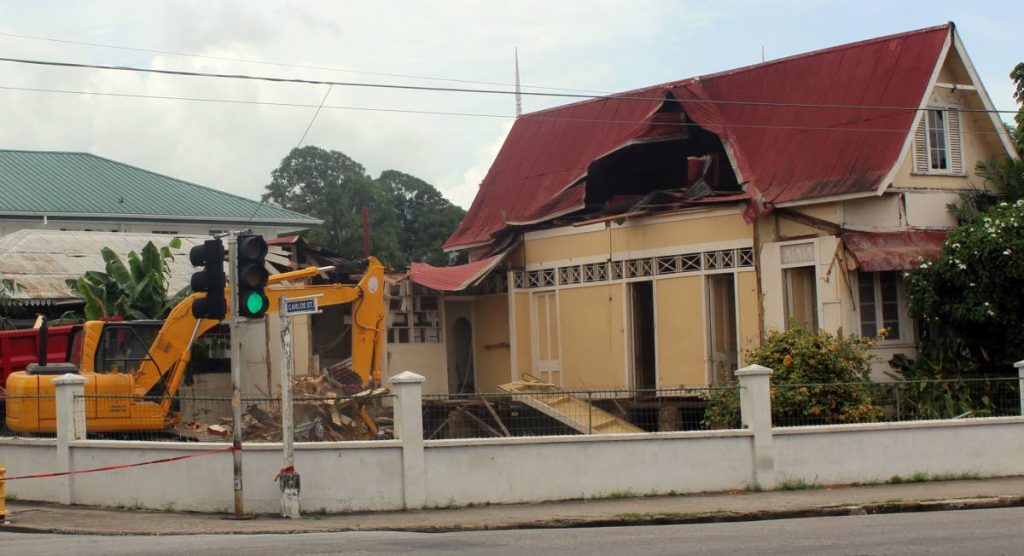Houses hold memories worth preserving

The house where I was born in London is still standing. The house my sister was born in is still standing. The house in Bradford my mother grew up in, still remains.
The house my great-grandfather built in the 1930s and where my grandmother spent most of her childhood was demolished in 1988. Further along that same road, the smaller house they lived in previously is still intact. It is made of dark grey stone. Like the houses I grew up in, it will endure.
They all sit on terraced streets from the late-Victorian and Edwardian periods and were built roughly between 1880 and 1910.
Last week on Ariapita Avenue, I witnessed a house built in the same era, over 100 years ago, torn down by mechanical diggers. Horrified, I leapt out of my car to record its final moments. It was the iconic “gingerbread” house on the corner of Carlos Street. Many Carnival parades have passed it by. No more shall.
My video triggered reflections and ruminations online. Somebody’s great aunt ran a florist there, Lee’s of Carlos Street. Another person got her wedding bouquet from the same aunt in 1959. The architect Mark Raymond called for collective action to thwart the deleterious eradication of residential buildings in Port of Spain.

Houses are more than just history, they are memories. In researching this column, I discovered that Charles Dickens once lived on the street where I was born, College Place in Camden Town. His landlady inspired Mrs Pipchin from my favourite book, Dombey and Son. While exhilarating to learn, I have no memory of living on College Place, so my emotional connection is less than with later houses that hold powerful memories. That we left them and others now dwell in them is still so poignant. I pass them often. I would be devastated if they were ever knocked down for commercial gain.
As gingerbread houses are unique to Trinidad, so terraced houses are unique to England. They are beautiful in their uniformity and solidity. They are going nowhere because of how they were built. To destroy them means destroying entire streets. Usually, where you see modern gaps in the terraced-housing labyrinth of London, it is because bombs flattened the old houses in WWII.
Usually, but not always. From the 1960s onwards, the value of property and land began to rise in the UK and housing companies began to buy up mostly council homes for “redevelopment” (ie to knock down and put up new, cheaply-built, commercially viable replacements.)
When I think about the demolition of the house my great-grandfather built I think of the song Paint A Vulgar Picture by The Smiths, in which the singer Morrissey sees his younger self, through the eyes of a rock star visiting his hometown, as faceless, fawning and boring, “a child from those ugly new houses.”
Morrissey’s original childhood home in Manchester was demolished and his family moved elsewhere. The effect on him was profound. The removal of what we like to call the “character” of the Victorian house he grew up in – however dismal it may have been – helped shape his romanticism for old things, rather than new.
Most things built today are ugly, I think it’s fair to say. The occasional beauty of skyscrapers glinting in the sun and twinkling at night is a nice, but well-worn, trick. From my terrace in Carenage I see downtown Port of Spain flashing in the distance, sometimes even shimmering in the heat of a muggy night. It is attractive but, in the longue durée of human inhabitance in Trinidad, ephemeral.
Looking the other way towards the Dragon’s Mouth, I used to see something more durable, and beautiful. We moved here just one year ago but in that short time our view down the islands has been gradually obscured by a row of nondescript two-storey houses that have gone up along a ridge overlooking the sea. Ageless charm hidden by modern rubbish.
What will appear in that void space on the Avenue that was once a family house and is now firewood in a furnace or litter in a landfill, only time will tell. A few feet away, the hideous commercial buildings, the gyro stands, bars and casinos, give us a clue.
Some people say good riddance to colonial relics, but what gets built in their place does nothing to improve our lived space, our well-being or our imagined future.
A few years ago, Greyfriars church was bulldozed into a car park, while just months before the Boissiere House was restored and preserved. The latter proves it is not impossible to save the past and avoid obliterating memories, but the mechanism by which the National Trust can prevent the architectural erasure of Trinidad’s past is hindered tremendously by a lack of private will and investment, and inadequate public laws on conservation and planning.


Comments
"Houses hold memories worth preserving"